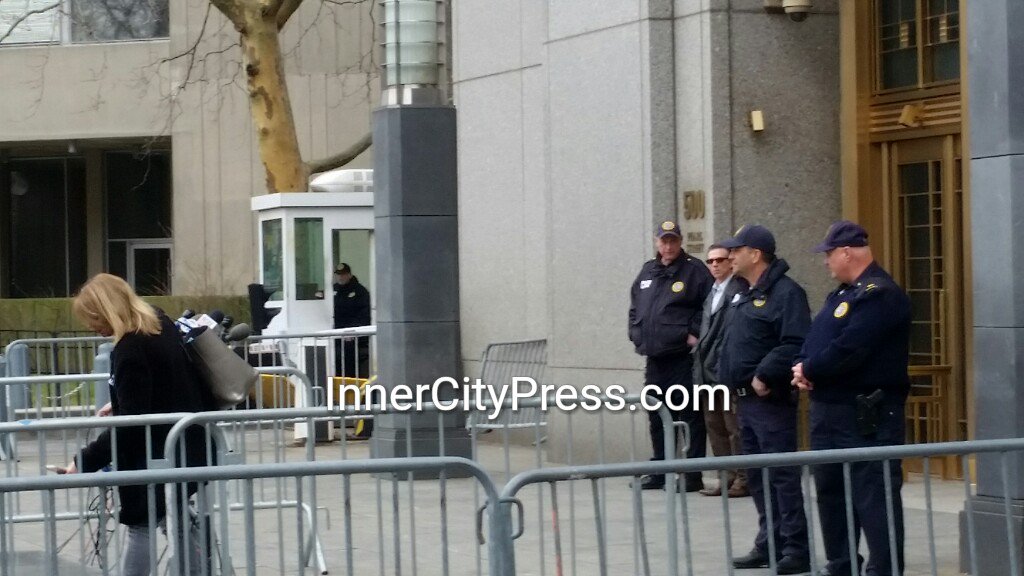SDNY COURTHOUSE, August 21 -- On April 19 soon after his prosecution for murder resulted in a mistrial, Defendant Frank Bright pleaded guilty.
That day Bright said: "On December 24, 2014, near 129th Street in Manhattan, I agreed with another person to rob oxycodone pills from two drug dealers. During the robbery, Mr. Paulino was shot and killed. I knew my actions were wrong and illegal."
U.S. District Court for the Southern District of New York Judge Katherine Polk Failla said, "Ms. Noriega, may I have a sentencing date?"
Ms. Noriega replied, "Tuesday, August 20, at 3:30 pm." Inner City Press went to the sentencing at that time.
In between, Bright on June 17 told Judge Failla, "I just felt like I was misled into taking this plea deal."
Then on July 19 Judge Failla toldBright's new counsel John C. Meringolo (whom Inner City Press previously covered when he represented John Zancocchio in a Mafia / racketeering trial before SDNY Judge Alvin K. Hellerstein) "Mr. Meringolo, I appreciate you coming in on what is somewhat short notice. I received a letter from your client dated the 7th of July and it was, in my reading, in conflict with other statements that have been made."
Meringolo said, "We still want to move forward with the plea sentencing."
And so on August 20 Assistant US Attorney Justin V. Rodriguez advocated for the 240 months that his Office had agreed to as the cap; he told Judge Failla that two of Amaury Paulino's sisters wanted to make victim impact statements.
Bright's family members in the gallery asked if they could make such statement.
No, Judge Failla said, the law does not provide for that. But when she went back into her robing room to come up with the seemingly pre-ordained sentence, one of Bright's family members went and expressed condolences to Amaury Paulino's family members. Another of Bright's family members, however, older, said loudly that one day you'll see who really killed your son. This was quickly hushed down.
Judge Failla returned and said no grounds for a variance below 240 months could be found; the 20 year sentence was imposed. It will apparently be in Fort Dix, with the RDAP program. Or will the replacement of counsel and the complaints made, the at least two pull-backs from the plea, give rise to an appeal? Watch this site. The case is US v. Bright, 18-cr-56 (KPF).
The previous day on August 20 a jury returned guilty verdicts on drugs and gun charges on August 20 against Ernest Murphy, one of 15 defendants in a Brooklyn-based narcotics conspiracy case brought by the U.S. Attorney for the Southern District of New York.
It came after some electronic and laboratory evidence was suppressed by Circuit Judge Richard J. Sullivan, who rather than re-assigning has kept many of his criminal cases in the SDNY.
Murphy's two Criminal Justice Act lawyers, Patrick Joyce and Robert Moore, complained to Judge Sullivan on the eve of trial that they had only then been given 16 gigabytes of audio and video recordings and lab tests on crack cocaine.
Rather than delay the trial, Judge Sullivan ordered much of it suppressed. During the five day trial the government still had a number of NYPD lab technicians testimony, and played wiretaps of cell phone calls and calls from Riker's Island, whose location in The Bronx was cited as a basis for venue in the SDNY.
In the intercepted calls, there was discussion of cooking, packaging and selling crack cocaine. Several times reference was made to bringing firearms to protect turf. A government slang expert witness said that "Shaquille" jersey meant .32 caliber pistol.
After the jury got the case, they asked to examine the drugs. Judge Sullivan declined to send the crack and ecstacy pills into the jury room. Instead the juror came out and passed them hand to hand, in evidence bags, in the jury box.
On the second day of deliberations the jury through the Court Security Officer passed a note that they wanted all audio recordings and transcripts. Judge Sullivan sent them in a thumb drive and three binders, as well as a menu to order lunch.
But barely an hour later, the jury returned with its guilty verdicts. Judge Sullivan polled them, sent December 6 as the sentencing date - Murphy faces a minimum of 15 years in prison and perhaps more - then joined the jurors for their lunch. The case is US v. Ernest Murphy,18-cr-373 (Sullivan).
The US Attorney's Office, which had sent senior AUSA Michael D. Maimin over to try to put out the fire occasioned by the late discovery, must have breathed a sigh of relief. Inner City Press will continue to cover this case - and, we hope, Judge Sullivan's sentencing in another case he kept, US v. Rodriguez (05-cr-221), which the government is asking, under seal, to have sealed. Watch this site.

Judge Sullivan several times during the trial pointedly noted that it is an open courtroom, a strength of our system, anyone can just walk in -- except for US v. Rodriguez, apparently, on which Inner City Press will have more, as well as on the differences between the SDNY's and EDNY's boiler plate plea agreement letters. Watch this site - and see also @InnerCityPressand the new @SDNYLIVE.